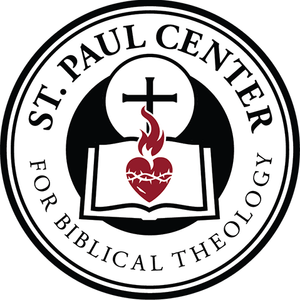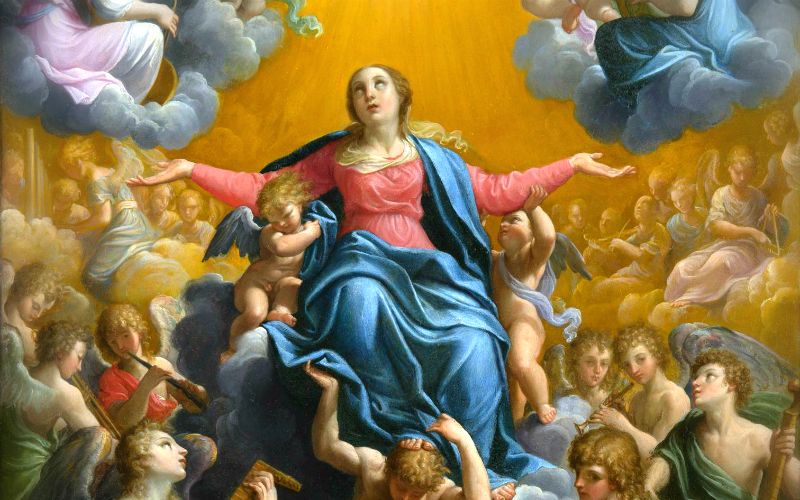Traditionally, Catholics have seen the woman in Revelation 12 as Mary.
Of course, just as other passages in Revelation have multiple meanings, Catholics affirm that the woman doesn’t only represent Mary. As we shall see, the “woman” must also be understood as “Daughter Zion,” depicted in Isaiah.
What reasons are there for recognizing the woman as Mary at all?
When one examines the way Revelation 11 leads into Revelation 12, the reasons for such an interpretation are clearly seen.
The ark of the covenant is the last thing John sees before the events of Revelation 12. The ark’s importance can’t be stressed enough.
During the Exodus, God’s presence appeared over the ark in the tabernacle, making it holy (Ex 40:34–38).
When the ark was captured by the Philistines, it was said, “The glory has departed from Israel, for the ark of God has been captured” (1 Sam 4:22). The Philistines returned the ark, however, because they broke out in tumors after they took it (1 Sam 5:6–12).
The ark was also holy because it contained (1) God’s word, that is, the Ten Commandments, written on the stone tablets; (2) bread from heaven, that is, the manna; and (3) the staff of Aaron, the high priest.
Nothing ritually unclean could touch the ark. When one man named Uzzah tried to catch the ark to prevent it from falling into the mud, he was killed on the spot for touching it (2 Sam 6:6–7).
Moreover, it was the “ark” that led Israel through the desert on their way to the Promised Land (Num 10:33–35).
When this ark was lost after the Babylonian invasion, it was nothing less than a national tragedy. People still speculate about its whereabouts today.
Now John, looking into God’s temple in the heavenly Jerusalem, sees that ark. But he just mentions it and moves on. This is surprising. You’d at least expect a little more about it, right? Yet John never mentions it again—or does he?
In Luke 1, Catholics find two stories familiar to them from the Rosary—the Annunciation of the angel Gabriel to Mary and Mary’s Visitation to her cousin Elizabeth. Both accounts evoke ark of the covenant imagery.
In the Annunciation, Mary is told, “The Holy Spirit will come upon you, and the power of the Most High will overshadow you” (Luke 1:35). The Greek word for “overshadow” is the same word used to describe God’s presence “overshadowing” the ark in the tabernacle in the Old Testament (Ex 40:34–38).
Mary is also compared to the ark in the story of the Visitation. Luke describes Mary’s visit to Elizabeth in ways that echo the story of David’s carrying the ark into Jerusalem.
Mary is the new ark because she bears within herself Jesus, who is (1) God’s Word in flesh, (2) the true Bread from heaven, and (3) the heavenly High Priest.
The early Fathers also noticed the parallels between Mary and the ark.
St. Methodius writes:
“For if to the ark, which was the image and type of thy sanctity, such honor was paid of God that to no one but to the priestly order only was the access to it open, or ingress allowed to behold it…
“…what sort of veneration is due to thee from us who are of creation the least, to thee who art indeed a queen; to thee, the living ark of God, the Lawgiver; to thee, the heaven that contains Him who can be contained of none?
“For since thou, O holy virgin, hast dawned as a bright day upon the world and hast brought forth the Sun of Righteousness, that hateful horror of darkness has been chased away.”
Similarly, St. Ephraim referred to Mary in his hymns, comparing her to the ark. St. John Damascene also preached on Mary’s role as the new ark, giving a spiritual interpretation to 2 Samuel as a foreshadowing of the Assumption.
Given the parallels of Mary and the ark, it should be no wonder that in Revelation 12, a vision concerning “a woman” who bears the Messiah follows a vision of the ark of God.
And it shouldn’t surprise us that John simply calls her “woman” and doesn’t use the name “Mary.” In the Fourth Gospel, John never mentions Mary’s name, but usually refers to her as “woman” (John 2:4; 19:6).
St. John Damascene and other Fathers may have been right, then, in understanding this passage as confirmation of the doctrine of the Assumption.
Damascene preached a homily on Revelation 12, in celebrating the Assumption, saying:
“This day the Holy and Singular Virgin is presented in the sublime and heavenly Temple…
“This day the sacred and living Ark of the Living God, who bore within her womb her own Creator, took up her rest within that Temple of the Lord that was not made with hands…And David her forefather, and her father in God, dances with joy.”
Thus, Damascene understood Revelation 12 to mean that, just as David brought the ark into Jerusalem, so too Christ brings the new ark, Mary, into the New Jerusalem of heaven.
So after we read in chapter 11 about the two witnesses who are taken into heaven, we then read in chapter 12 of the “woman” in heaven.
This article originally appeared on Scott Hahn’s St. Paul Center blog.
[See also: Do We Know the Year of Mary’s Assumption? Here’s the Intriguing Evidence]
[See also: Why Was Mary “Assumed” While Jesus “Ascended”? The Answer Matters]


